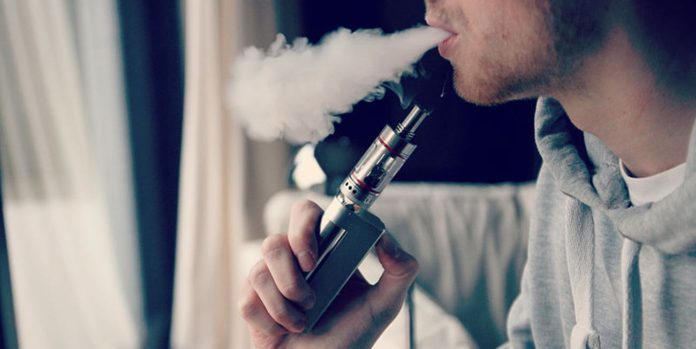Vaping is a dangerous new fad that has swept the country leaving schools full of addicted students in its wake. Over 25% of students will begin vaping daily by the time they reach senior year. That number is comparable to the amount of high schoolers that smoked cigarettes daily in the 1970’s. Originally created and marketed as an easy way to quit smoking, vaping quickly gained traction with teens because of its supposedly harmless nature. Studies have shown, however, that vaping is incredibly dangerous and should be treated with extreme caution. One reason why teens have been so attracted to vaping is because of the flavored pods. Flavors such as berry and mango even promise health benefits to users. This false advertising distracts many from the fact that 99% of pods contain significant amounts of nicotine. Nicotine drastically affects the behavior of developing teens, their ability to learn, and even makes drugs such as methamphetamine and cocaine more pleasurable to the brain. This means that vaping increases the likelihood of getting addicted to more dangerous drugs. New research has shown that those who vape have a 71% higher risk of having a stroke and a 59% higher risk for having a heart attack. In addition, vaping causes a 40% higher risk for heart disease. Vape pods contain a certain type of flavoring called diacetyl, a chemical that is linked to a serious lung disease known as popcorn lung. Benzene, a gas which is found in car exhaust, is also inhaled when vaping.
In light of the recent closings of the school bathrooms (which have since been reopened) on the first and third floors, student vapers were anonymously interviewed to determine the effect that the closings have had on their vaping habits, either positive or negative. All interviews were conducted anonymously as to protect the privacy of each individual.
Most seniors felt uncomfortable being asked to participate in the investigation, however one male senior gave us a brief insight into the world of vaping as a senior at St. Anthony’s. Throughout the interview he expressed, repeatedly, that he believed vaping was “stupid”. He continued to use many derogatory slurs to describe people who vaped, giving the clear impression that, even though many of his friends had tried it, he felt very negatively about vaping in general. He had noticed a sharp increase in vaping among his peers in the last few years and claimed that the only way to ensure that vaping would stop in school bathrooms is to put a security guard in each bathroom. When asked what he would say to people who are just beginning to vape, he replied, “Don’t do it. You’ll be addicted to drugs in 20 years”.
One junior male agreed to be interviewed given that the investigation remained anonymous. Although he had personally never vaped, he stressed the fact that all of his friends do. He claimed that it gained popularity in eighth grade but he never considered it “cool”. His friends continued to vape in school bathrooms despite the controversial closings. His only solution to the vaping problem was putting vapor sensors in the bathrooms although he continues to believe that nothing will truly stop the vapers.
Three sophomores were willing to participate in the investigation. The first, a male in three honors classes, began vaping during the summer before his freshman year due to peer pressure from his friends. He continued to explain the seemingly harmless first experience saying, “I just wanted one hit. I thought that would be it”. This snowballed into a year and half long struggle of vaping throughout the day in school bathrooms. He purchased his vape pen and pods from older friends and upperclassmen for about thirty dollars. He first realized he had a problem when he was consuming four pods a day. At five dollars a pod, that was twenty dollars each and every day. He worked as a lifeguard and used all of his lunch money to buy more pods. He seem eager to get this information out in the open, as though he felt guilty for his actions. Towards the end of the interview he brought up the surprisingly long and tedious process of quitting. Vaping brought down his stamina and made him lose his appetite. After his decision to quit, it took months to wean himself off of his daily habit. He became so frustrated with the process that he threw away his vape pen so that he would be forced to stop. He chose not to sell it because he didn’t want anyone else to experience the pain that he felt. Despite all of this, he still has occasional urges to vape. He stressed that if you do it once, you will never be completely clean. Since the closing of the bathrooms, a few of his friends have decided to quit but others have found new places around the school to vape. When asked what he would say to people thinking of starting to vape, he said, “Just don’t do it. It’s so stupid. It’s the worst thing for you. The worst decision. It’s not cool.” Unfortunately, soon after the interview, our subject began vaping again. A few weeks after he resumed vaping, he smashed his vape pen with a hammer. His current vaping status is unknown.
The second sophomore source is a female, who is currently enrolled in one AP class. She began vaping at the end of freshman year after experiencing a great deal of peer pressure from her friends. Ironically enough, her first experience vaping was in a school bathroom. When asked how she felt about the experience she responded that she was unremorseful because she “…felt like an adult”. After this first experience she purchased a vape pen at her local convenience store and continued to vape. The subject declined to tell us how she was able to purchase the materials, only that her parents were supportive of her vaping believing it to be less harmful than other forms of drug use. She stopped vaping at the beginning of the school year because she lost her vape pen and didn’t want to spend the money to purchase another one. She didn’t know about the risks of vaping when she began and with her current knowledge about the health risks involved, she said that the high she felt wasn’t worth it.
The third sophomore was a female who began vaping in eighth grade due to peer pressure. She would vape on Saturday nights at the local park with her close friend and a group of older kids that she didn’t know. She didn’t know the negative effects of vaping when she began and seemed shocked when we read aloud the statistics. She claimed that after a few weeks she realized that her group of friends were bad influences and she distanced herself from them. She has not vaped since.
The one freshman male that was interviewed had never vaped although many of his friends are constant vapers. He vocalized that he would never consider vaping because of the knowledge that it would negatively affect his lacrosse performance. Coming from a Catholic middle school, he stated that vaping gained popularity when he was in the eighth grade. He wished that there had been assemblies to inform students about the dangers of vaping because many people may not have begun had they been aware of the health risks. His friends that currently vape, however, continue to use school bathrooms daily. As an upstanding student at St. Anthony’s, the freshman said that the bathrooms being closed did nothing but punish those who just want to use the bathroom in between classes.
In conclusion, there are many vapers present in our St. Anthony’s community. Closing the bathrooms were not 100% effective in preventing students from vaping during school hours. The closed bathrooms were an inconvenience for many, causing long lines and missed class time. Preventative measures are necessary to protect incoming students who may not know the risks involved with vaping. It would be nearly impossible to completely eradicate vaping from our campus. However, it is very possible to diminish the popularity of vaping by transforming it from something that is considered cool to something that is viewed as disgusting and undesirable. The most effective way to do this is through peer pressure. Just as peer pressure has caused many students to begin vaping, peer pressure in the opposite direction could prevent students from vaping to begin with. In most public schools there are assemblies in the beginning of the year that outline the risks and dangers of smoking, vaping, and abusing drugs and alcohol. These presentations, similar to the anti-smoking PSAs that are sometimes seen on television, use videos and images to convey their anti-drug message. In order to be most effective, these presentations should be shown on the orientation days at the beginning of the school year. Knowing that these health disorders could affect their friends would cause many students to encourage others to stay far away from these harmful devices.
Written by: Sam Stueber and Xiomara Smyth








